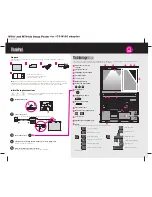
Crestron
e-control Vote SW-VOTE
74
••
Appendices
Installation & Reference Guide — DOC. 5822
Appendix C: Signal Reference
Definition of Terms
Data fields
The indirect text fields which receive the data that is echoed
when a record is opened (“picked”).
Connection
A connection to a system which can be either serial
(RS-232) or EtherNet (TCP/IP).
List fields
The indirect text fields in scrollers. There can be more than
one field (column) per row in the scroller.
Scroller
(1) Scrolling lists as displayed on touchpanels, made up of
(a) a column of buttons containing indirect text fields, along
with (b) transport buttons, and (c) an optional analog gauge
object serving as a scrollbar. Also (2) the signal block which
services such a construct.
Server
The Crestron Software Server. That is,
swserver.exe
running on a Windows PC.
Signal Block
Active component within the Server, which listens for and
responds to signals from connected control systems. For
example, each scroller requires its own signal block. If not
specified explicitly as some other type of signal block,
refers to a standard scroller signal block.
System
A Crestron
control processor along with appropriate
programming.
String Proxies
The various
Echo
signals keep a server-side “proxy” of the data last sent to the
system. Before sending, the new value is compared with the proxy and is only
actually sent if it differs. The proxy is then updated to match the new value. In this
way, identical string data are not continually resent.
Bit Patterns
For those unfamiliar with bit patterns, here is a primer.
Base 2 Basics
A quantity is represented in computer memory as a binary (base 2) number (
i.e.,
a
string of 1s and 0s). As you know, in base 10, the least significant (low-order)
“digits” are on the right, and the most significant (high-order) are on the left. This is
also true of base 2: The lowest order “bit,” (binary digit), on the far right, and are
numbered starting from 0. Thus, when sixteen bits are available, they are numbered 0
to 15 from right to left — because each bit on its own represents the quantities 2
0
through 2
15
.
Bit patterns as used here do not represent quantities. Rather, the values of the
individual bits (0 or 1) turn features off and on (respectively). Thus, when the
documentation refers to Bit 5 as controlling feature X, this means that feature X is
“enabled” when Bit 5 is set to 1.
















































